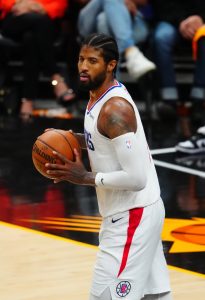An NBA team that has spent all its cap space and doesn’t have any of its mid-level or bi-annual exception available still always has the ability to sign a player to a minimum-salary contract, unless that club is right up against its hard cap.
Teams with cap room or with access to the non-taxpayer mid-level exception will have a little more flexibility to sign players to longer-term minimum-salary contracts. However, teams without cap room and without any other exceptions on hand can still use the minimum salary exception to add as many players as roster limits and the hard cap allow, for contracts of up to two years. Unlike other exceptions, such as the mid-level or the bi-annual, the minimum salary exception can be used multiple times.
[RELATED: Values of 2021/22 mid-level, bi-annual exceptions]
Undrafted free agents and second-round picks are often recipients of minimum-salary contracts, but there are plenty of veterans who end up settling for the minimum too. Because a player’s minimum salary is determined by how much NBA experience he has, many veterans will earn more than twice as much money as a rookie will in 2021/22 on a minimum-salary contract.
Listed below are 2021/22’s minimum salary figures, sorted by years of NBA experience. If a player spent any time on an NBA club’s active regular season roster in a given season, he earned one year of experience. So any player with zero years of experience has not yet made his NBA debut.
These figures represent a 3% increase on last season’s figures, since that’s the amount of the NBA’s salary cap increase for 2021/22.
Here’s the full breakdown:
| Years of Experience |
Salary |
| 0 |
$925,258 |
| 1 |
$1,489,065 |
| 2 |
$1,669,178 |
| 3 |
$1,729,217 |
| 4 |
$1,789,256 |
| 5 |
$1,939,350 |
| 6 |
$2,089,448 |
| 7 |
$2,239,544 |
| 8 |
$2,389,641 |
| 9 |
$2,401,537 |
| 10+ |
$2,641,691 |
Because the NBA doesn’t want teams to avoid signing veteran players in favor of cheaper, younger players, the league reimburses clubs who sign veterans with three or more years of experience to one-year, minimum salary contracts. Those deals will only count against the cap – and against a team’s bank balance – for $1,669,178, the minimum salary for a player with two years of experience.
For instance, Trevor Ariza, who has 17 seasons of NBA experience, is signing a one-year, minimum-salary contract with the Lakers, who will only be charged $1,669,178 for Ariza’s contract. He’ll earn $2,641,691, but the NBA will make up the difference. This only applies to one-year contracts, rather than multiyear deals.
If a player signs a minimum-salary contract after the regular season begins, he’ll earn a prorated portion of the amount listed above.
Those figures listed above also only apply to players who are signing new contracts in 2021/22. Players who are in the second, third, or fourth year of a minimum-salary deal will be earning a slightly different predetermined amount.
For example, a player like Spurs guard Tre Jones – who signed a minimum-salary contract last offseason and now has one year of NBA experience – will earn a $1,517,981 salary in the second year of his contract, exceeding the $1,489,065 he’d receive if he were signing a new minimum deal this fall. That’s because his second-year salary is based on a 5% raise over last season’s minimum salary for a player with one year of experience.
Here’s what multiyear minimum-salary contracts signed in 2021/22 will look like:
Experience
|
2021/22 |
2022/23 |
2023/24 |
2024/25 |
| 0 |
$925,258 |
$1,563,518 |
$1,836,096 |
$1,988,598 |
| 1 |
$1,489,065 |
$1,752,638 |
$1,902,137 |
$2,057,646 |
| 2 |
$1,669,178 |
$1,815,677 |
$1,968,182 |
$2,230,253 |
| 3 |
$1,729,217 |
$1,878,720 |
$2,133,285 |
$2,402,862 |
| 4 |
$1,789,256 |
$2,036,318 |
$2,298,390 |
$2,575,475 |
| 5 |
$1,939,350 |
$2,193,920 |
$2,463,498 |
$2,748,090 |
| 6 |
$2,089,448 |
$2,351,521 |
$2,628,607 |
$2,761,767 |
| 7 |
$2,239,544 |
$2,509,123 |
$2,641,690 |
$3,037,946 |
| 8 |
$2,389,641 |
$2,521,613 |
$2,905,862 |
$3,037,946 |
| 9 |
$2,401,537 |
$2,773,776 |
$2,905,862 |
$3,037,946 |
| 10+ |
$2,641,691 |
$2,773,776 |
$2,905,862 |
$3,037,946 |
Technically, a minimum-salary contract could cover five years for a player with full Bird rights, but in actuality, that never happens. While some second-round picks and undrafted free agents will sign three- or four-year minimum-salary contracts, a minimum deal exceeding two years is rare for a player with more than a year or two of NBA experience under his belt.
Information from RealGM was used in the creation of this post.
 Listed below are the maximum-salary contracts for players signing contracts that start in 2021/22. The first chart shows the maximum salaries for a player re-signing with his own team — a player’s previous team can offer five years instead of four, and 8% annual raises instead of 5% raises. The second chart shows the maximum salaries for a player signing with a new team.
Listed below are the maximum-salary contracts for players signing contracts that start in 2021/22. The first chart shows the maximum salaries for a player re-signing with his own team — a player’s previous team can offer five years instead of four, and 8% annual raises instead of 5% raises. The second chart shows the maximum salaries for a player signing with a new team.